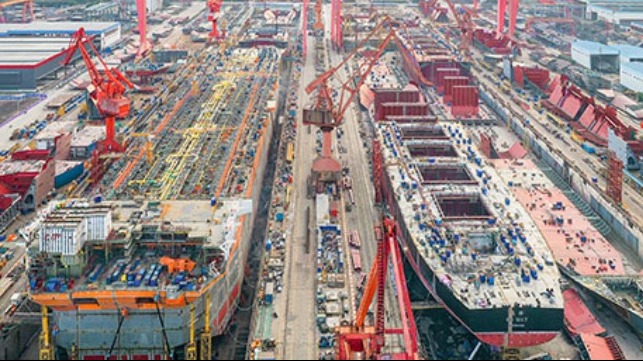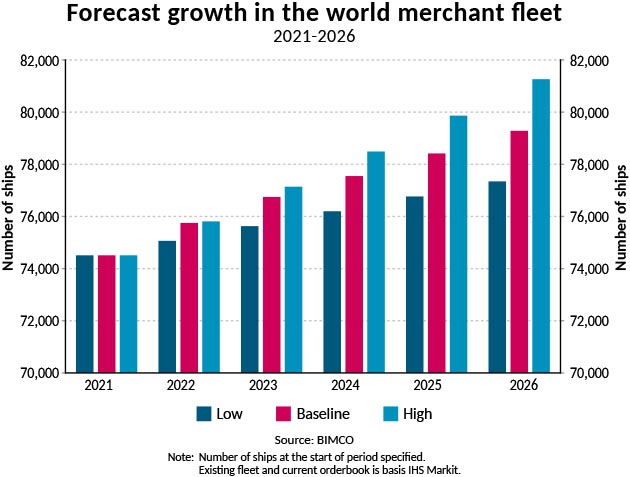BIMCO Expects World Fleet Will Grow at Slower Pace in the Next 5 Years

Despite the recent flurry of construction orders coming primarily in the containership and gas carrier segments, BIMCO in its new analysis of global shipbuilding in forecasting a slowing growth rate for the world’s fleet in the next five years compared to the last five years.
The shipping trade association points to the fact that despite new orders for containerships currently at a 14-year-high, global shipyards are under pressure. Based on the current pace of the market, BIMCO says that 2021 is heading towards being the third-lowest level of newbuilding orders in 12 years.
The trading world merchant fleet had a capacity of 74,505 ships across 11 main segments, according to BIMCO. In their baseline scenario, the total fleet is projected to reach 79,282 by the end of 2025. That would represent 6.4 percent growth over the five years, down from 7.4 percent in the previous five years. From 2021 onwards, BIMCO projects the fleet to have a compound annual growth rate (CAGR) of 1.25 percent in a baseline scenario until the start of 2026. The CAGR for the previous five years is 1.44 percent. In addition to the baseline, a low and a high scenario is provided to consider the impact from various degrees of uncertainty for the future number of ships in the market.

The world merchant fleet is expected to grow in all three scenarios over the upcoming years. In a scenario where a weaker-than-the-baseline outlook for global trade is considered, the fleet will grow at a slower pace and is expected to have a compound annual growth rate (CAGR) of 0.75 percent. In the low growth scenario, there will be on average 567 ships entering the fleet every year, a significant decline from the baseline average of 955. With a brighter outlook for global trade, the world fleet is set to exceed 80,000 ships during 2025, with a set annual growth rate of 1.75 percent.
The most substantial growth rate by any of the considered 11 segments during 2020 through 2025 according to BIMCO will likely be the LNG tankers. This equated to the coming global shift away from crude oil and the rapidly increasing use of LNG, including in the shipping industry. DNV, for example, recently reported that there are 200 ocean going LNG-powered vessels operating with 300 additional ships capable of operating on LNG currently on order.
According to BIMCO, the LNG tanker fleet currently consists of 593 ships, and 85 percent of the fleet has a cargo carrying capacity in the range of 100,000-200,000 cubic meters. In BIMCO’s baseline scenario the LNG tanker fleet would reach 819 vessels at the end of 2025. The range is between 799 ships in a low growth scenario to 839 ships in a high growth scenario.
While the market for crude tankers was negatively affected during the pandemic, BIMCO notes that the fleet has seen more than 40 new orders during the year to date. The crude tanker fleet consists of 2,976 ships, according to the IHS Markit data, and 34 percent of that fleet consists of ships in the range of 80,000-120,000 dwt. BIMCO expects the fleet to expand in the longer term by just under three percent on average each year until the end of 2025, with VLCC driving most of the growth.
Cruise liners are also expected to see significant fleet growth by 2026. Despite being the second-smallest segment of the world merchant fleet by numbers, with an end-year 2020 total of 621 ships, the cruise lines are expected to increase with a compound annual growth rate of over four percent in BIMCO’s baseline scenario. Regardless of a low or high growth scenario, the fleet will deviate with 19 ships from the baseline of 763 ships in 2026.
Containerships are currently the fastest growing segment. So far this year, BIMCO reports 229 ships totaling 2.2m TEU have been added to the order book. This compares with deliveries of 393,566 TEU, leaving a combined orderbook of 4.35 million TEU, more than twice the size it was eight months ago when containership orders bottomed out at 1.95 million TEU. Surging profits and high demand have driven the strong demand for new containership orders. However, it is unlikely that the segment can maintain this growth rate.
BIMCO also points out that the growth in shipping will also directly impact seafarers and the profession. They noted that seafarers have also been under pressure during the pandemic. The expected demand for seafarers in the future is impacted by the forecasted growth in the world fleet.
